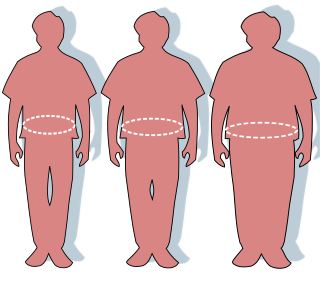Related Research Articles

Body mass index (BMI) is a value derived from the mass (weight) and height of a person. The BMI is defined as the body mass divided by the square of the body height, and is expressed in units of kg/m2, resulting from mass in kilograms (kg) and height in metres (m).

Abdominal obesity, also known as central obesity and truncal obesity, is the human condition of an excessive concentration of visceral fat around the stomach and abdomen to such an extent that it is likely to harm its bearer's health. Abdominal obesity has been strongly linked to cardiovascular disease, Alzheimer's disease, and other metabolic and vascular diseases.

Obesity is a medical condition, sometimes considered a disease, in which excess body fat has accumulated to such an extent that it negatively affects health. People are classified as obese when their body mass index (BMI)—a person's weight divided by the square of the person's height—is over 30 kg/m2; the range 25–30 kg/m2 is defined as overweight. Some East Asian countries use lower values to calculate obesity. Obesity is a major cause of disability and is correlated with various diseases and conditions, particularly cardiovascular diseases, type 2 diabetes, obstructive sleep apnea, certain types of cancer, and osteoarthritis.
The anthropometry of the upper arm is a set of measurements of the shape of the upper arms.
The body fat percentage (BFP) of a human or other living being is the total mass of fat divided by total body mass, multiplied by 100; body fat includes essential body fat and storage body fat. Essential body fat is necessary to maintain life and reproductive functions. The percentage of essential body fat for women is greater than that for men, due to the demands of childbearing and other hormonal functions. Storage body fat consists of fat accumulation in adipose tissue, part of which protects internal organs in the chest and abdomen. A number of methods are available for determining body fat percentage, such as measurement with calipers or through the use of bioelectrical impedance analysis.
Bioelectrical impedance analysis (BIA) is a method for estimating body composition, in particular body fat and muscle mass, where a weak electric current flows through the body and the voltage is measured in order to calculate impedance of the body. Most body water is stored in muscle. Therefore, if a person is more muscular there is a high chance that the person will also have more body water, which leads to lower impedance. Since the advent of the first commercially available devices in the mid-1980s the method has become popular owing to its ease of use and portability of the equipment. It is familiar in the consumer market as a simple instrument for estimating body fat. BIA actually determines the electrical impedance, or opposition to the flow of an electric current through body tissues which can then be used to estimate total body water (TBW), which can be used to estimate fat-free body mass and, by difference with body weight, body fat.

Being overweight or fat is having more body fat than is optimally healthy. Being overweight is especially common where food supplies are plentiful and lifestyles are sedentary.
Lean body mass (LBM), sometimes conflated with fat-free mass, is a component of body composition. Fat-free mass (FFM) is calculated by subtracting body fat weight from total body weight: total body weight is lean plus fat. In equations:

Obesity in pets occurs when excessive adipose tissue accumulates in the body, and is generally defined as occurring when an animal's body weight is at least 20% greater than its optimal body weight. Obesity is associated with metabolic and hormonal changes, and can predispose pets to illnesses like orthopedic disease, diabetes, and cancer.

Obesity classification is a ranking of obesity, the medical condition in which excess body fat has accumulated to the extent that it has an adverse effect on health. The World Health Organization (WHO) classifies obesity by body mass index (BMI). BMI is further evaluated in terms of fat distribution via the waist–hip ratio and total cardiovascular risk factors. In children, a healthy weight varies with age and sex, and obesity determination is in relation to a historical normal group.

Android fat distribution describes the distribution of human adipose tissue mainly around the trunk and upper body, in areas such as the abdomen, chest, shoulder and nape of the neck. This pattern may lead to an "apple”-shaped body or central obesity, and is more common in males than in females. Thus, the android fat distribution of men is about 48.6%, which is 10.3% higher than that of premenopausal women. In other cases, an ovoid shape forms, which does not differentiate between men and women. Generally, during early adulthood, females tend to have a more peripheral fat distribution such that their fat is evenly distributed over their body. However, it has been found that as females age, bear children and approach menopause, this distribution shifts towards the android pattern of fat distribution, resulting in a 42.1% increase in android body fat distribution in postmenopausal women. This could potentially provide evolutionary advantages such as lowering a woman's center of gravity making her more stable when carrying offspring.
The body adiposity index (BAI) is a method of estimating the amount of body fat in humans. The BAI is calculated without using body weight, unlike the body mass index (BMI). Instead, it uses the size of the hips compared to the person's height.
A person's waist-to-height ratio (WHtR), occasionally written WtHR or called waist-to-stature ratio (WSR), is defined as their waist circumference divided by their height, both measured in the same units. It is used as a predictor of obesity-related cardiovascular disease. The WHtR is a measure of the distribution of body fat. Higher values of WHtR indicate higher risk of obesity-related cardiovascular diseases; it is correlated with abdominal obesity.
The Marsden Medal is a yearly award given by the New Zealand Association of Scientists. It is named after Sir Ernest Marsden and honours "a lifetime of outstanding service to the cause or profession of science, in recognition of service rendered to the cause or profession of science in the widest connotation of the phrase." It rivals the Rutherford Medal from the Royal Society of New Zealand.
A number of lifestyle factors are known to be important to the development of type 2 diabetes including: obesity, physical activity, diet, stress, and urbanization. Excess body fat underlies 64% of cases of diabetes in men and 77% of cases in women. A number of dietary factors such as sugar sweetened drinks and the type of fat in the diet appear to play a role.

Gynoid fat is the body fat that forms around the hips, breasts and thighs. Gynoid fat in females is used to provide nourishment for offspring, and is often referred to as 'reproductive fat'. This is because it contains long-chain polyunsaturated fatty acids (PUFAs), which are important in the development of fetuses. However, it is also regarded as a physically attractive feature and serves additionally as an indication towards a woman's reproductive potential for mates.
Sarah Louise Young is a New Zealand immunology academic, and as of 2019 is a full professor and head of pathology at the University of Otago.
Rachel C. Brown is a New Zealand scientist, professor and deputy head of the Department of Human Nutrition at the University of Otago.
Lisa Anne Houghton is a New Zealand-based scientist, professor and head of the Department of Human Nutrition at the University of Otago.
Paul Deurenberg is a Dutch retired academic, nutritional biochemist and consultant. He was a former associate professor in the Department of Human Nutrition at Wageningen University (WU), and is most known for his research expertise in the areas of energy metabolism, food consumption, and body composition studies.
References
- 1 2 Medicine, Dunedin School of. "DSM staff profile". Otago.ac.nz. Retrieved 3 March 2019.
- ↑ "Rachael Taylor promoted to full professor". Otago.ac.nz. Retrieved 3 March 2019.
- ↑ "Calls to target junk food ads". Odt.co.nz. 26 June 2018.
- ↑ "Mess is best to get in the mood for food". Odt.co.nz. 11 July 2017.
- ↑ "Research suggests child obesity can be tackled by simple sleep interventions". Medicalexpress.com.
- ↑ "Babies who eat widely and feed themselves less fussy as they age - study". Stuff.co.nz. 10 July 2017.
- ↑ "New Zealanders are fat and in denial about it, says survey". Stuff.co.nz. 10 February 2016.
- ↑ "View our fellows". Royal Society Te Apārangi. Retrieved 31 August 2023.